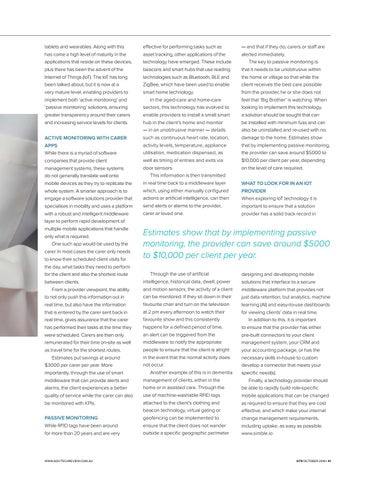tablets and wearables. Along with this has come a high level of maturity in the applications that reside on these devices, plus there has been the advent of the Internet of Things (IoT). The IoT has long been talked about, but it is now at a very mature level, enabling providers to implement both ‘active monitoring’ and ‘passive monitoring’ solutions, ensuring greater transparency around their carers and increasing service levels for clients. ACTIVE MONITORING WITH CARER APPS While there is a myriad of software companies that provide client management systems, these systems do not generally translate well onto mobile devices as they try to replicate the whole system. A smarter approach is to engage a software solutions provider that specialises in mobility and uses a platform with a robust and intelligent middleware layer to perform rapid development of multiple mobile applications that handle only what is required. One such app would be used by the carer. In most cases the carer only needs to know their scheduled client visits for the day, what tasks they need to perform for the client and also the shortest route between clients. From a provider viewpoint, the ability to not only push this information out in real time, but also have the information that is entered by the carer sent back in real time, gives assurance that the carer has performed their tasks at the time they were scheduled. Carers are then only remunerated for their time on-site as well as travel time for the shortest routes. Estimates put savings at around $3000 per carer per year. More importantly, through the use of smart middleware that can provide alerts and alarms, the client experiences a better quality of service while the carer can also be monitored with KPIs. PASSIVE MONITORING While RFID tags have been around for more than 20 years and are very
WWW.GOVTECHREVIEW.COM.AU
effective for performing tasks such as asset tracking, other applications of the technology have emerged. These include beacons and smart hubs that use reading technologies such as Bluetooth, BLE and ZigBee, which have been used to enable smart home technology. In the aged-care and home-care sectors, this technology has evolved to enable providers to install a small smart hub in the client’s home and monitor — in an unobtrusive manner — details such as continuous heart rate, location, activity levels, temperature, appliance utilisation, medication dispensed, as well as timing of entries and exits via door sensors. This information is then transmitted in real time back to a middleware layer which, using either manually configured actions or artificial intelligence, can then send alerts or alarms to the provider, carer or loved one.
— and that if they do, carers or staff are alerted immediately. The key to passive monitoring is that it needs to be unobtrusive within the home or village so that while the client receives the best care possible from the provider, he or she does not feel that ‘Big Brother’ is watching. When looking to implement this technology, a solution should be sought that can be installed with minimum fuss and can also be uninstalled and re-used with no damage to the home. Estimates show that by implementing passive monitoring, the provider can save around $5000 to $10,000 per client per year, depending on the level of care required. WHAT TO LOOK FOR IN AN IOT PROVIDER When exploring IoT technology it is important to ensure that a solution provider has a solid track record in
Estimates show that by implementing passive monitoring, the provider can save around $5000 to $10,000 per client per year. Through the use of artificial intelligence, historical data, dwell, power and motion sensors, the activity of a client can be monitored. If they sit down in their favourite chair and turn on the television at 2 pm every afternoon to watch their favourite show and this consistently happens for a defined period of time, an alert can be triggered from the middleware to notify the appropriate people to ensure that the client is alright in the event that the normal activity does not occur. Another example of this is in dementia management of clients, either in the home or in assisted care. Through the use of machine-washable RFID tags attached to the client’s clothing and beacon technology, virtual gating or geofencing can be implemented to ensure that the client does not wander outside a specific geographic perimeter
designing and developing mobile solutions that interface to a secure middleware platform that provides not just data retention, but analytics, machine learning (AI) and easy-to-use dashboards for viewing clients’ data in real time. In addition to this, it is important to ensure that the provider has either pre-built connectors to your client management system, your CRM and your accounting package, or has the necessary skills in-house to custom develop a connector that meets your specific need(s). Finally, a technology provider should be able to rapidly build role-specific mobile applications that can be changed as required to ensure that they are cost effective, and which make your internal change management requirements, including uptake, as easy as possible. www.simble.io
GTR OCTOBER 2016 | 41
